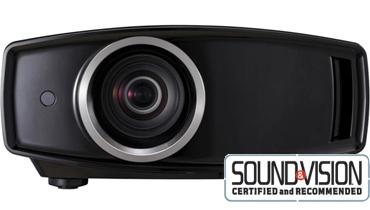JVC DLA-HD750 Front Projector

| The Short Form |
| $7,999 / JVC.com |
| Snapshot |
| The DLA-HD750 delivers stunning performance with no flaws worth mentioning. And the fact that it manages this after only a few minutes of adjustment makes it one of the finest video displays we've ever tested. |
| Plus |
| • Excellent contrast without auto iris • Excellent picture without fussy calibration • Excellent setup flexibility without annoying limitations |
| Minus |
| • Non-excellent remote without a THX button or discrete input selectors. |
| Key Features |
| • 1080p resolution • 2x zoom lens • Accepts 1080p/24 input signals • Motorized zoom, focus, and lens shift • Anamorphic zoom mode for sled-mounted constant-height lenses • Automatic lens cover • Inputs: 2 HDMI, VGA, component-, composite-, and S-video: RS 232C • 6 5/8 x 18 7/8 x 14 3/8in, 24 1/4 pounds |
People around the world admire the civility of the Japanese. When others might say, "You're totally wrong!," in the Land of the Rising Sun, they generally state, "That is not the case." When the rest of the world would scream, "No way in hell!," the Japanese calmly reply, "We will study your proposal." That's why I was so shocked to read JVC's promotional materials for its new DLA-HD750 projector.
On the company's Web page, it says, "There is neither an iris mechanism nor a compromise in the DLA-HD750 projector." In other words, every projector that uses auto iris--including Sony's identically priced VPL-VW70--is compromised and therefore inferior. If a well-mannered Japanese company like JVC comes out swinging like this, there must be something special lurking inside the DLA-HD750's elegant chassis.
And there is. JVC spent more than a decade refining its D-ILA projection technology, otherwise known by the generic name LCoS (Liquid Crystal on Silicon). That's more experience than any competitor can boast. So when JVC claims the DLA-HD750 has "the industry's highest native contrast ratio," one is duty-bound to investigate rather than scream, "No way in hell!"
The DLA-HD750 is one of a mere handful of video projectors to earn the THX certification. (The only other brands boasting this status are Runco and the moribund Vidikron.) The THX-certification process involves an evaluation comparable to the one we at Sound & Vision perform. It checks for adherence to standards set by such governing bodies as the American National Standards Institute (ANSI), the Society of Motion Picture and Television Engineers (SMPTE), and the Video Electronics Standards Association (VESA). It also incorporates several proprietary test patterns developed by THX.
All THX-certified projectors offer a THX Movie mode, which basically ensures that such settings as color temperature and gamma are correct. It also locks you out of any adjustments that might mess up the pictures. THX says all projectors it certifies must have a THX-mode button on the remote, but I must point out that with the DLA-HD750, that's not the case: You have to go through the onscreen menu to get into THX mode. Strangely, though, JVC includes dedicated buttons for every other picture preset, including the ghastly-looking Dynamic mode.
SETUP I set up the DLA-HD750 with my usual 72-inch wide, 16:9 Stewart Filmscreen StudioTek screen, and also tried it on a 106-inch wide, 2.35:1 Da-Lite JKP Affinity screen with a Panamorph UH480 anamorphic lens. The DLA-HD750's lens makes basic setup a snap. Everything's motorized, including focus, zoom, and lens-shift. With a wide 2x zoom range and a vertical lens-shift range of 80%, you can place this projector almost anywhere that's convenient and still get a great picture. Were I a professional home theater designer, this flexibility alone would be enough to sell me on the DLA-750HD.
Once the projector warmed up, I switched immediately to the THX mode to find out if it really does deliver the great out-of-the-box picture it promises. After mere minutes of first setting the brightness, contrast, color and hue, and manually tuning the iris down some to mute the 200-watt bulb's powerful output, I confirmed that color tracking in the THX mode was practically perfect, averaging 6,437 kelvins. That's only a hair off of the 6,500-K standard. I was able to get only a smidgen closer (an average of 6,547 K) by calibrating the projector myself.
But the color looked somewhat under saturated in THX mode. I found when I measured the color decoder performance that either red or green was under saturated, depending on the input selected. This error can be corrected using the projector's color-management controls...except that you're locked out of those controls in THX mode. This limitation might make the projector idiot-proof, but it also prevents it from achieving true perfection in THX mode. My best solution was to raise the color control in the menu by a couple of notches, which didn't look quite right on color-bar test patterns but definitely looked better with movies.
The color-management controls allow precise tuning of all six primary/secondary colors, but I didn't need these since all of the color points conformed almost perfectly to the SMPTE HD standard. The gamma-adjustment menu is similarly flexible--and unneeded. You can set gamma by number or tune it in 10 IRE steps. You can even set it separately for red, green, and blue. But I found that the Normal factory preset looked great. All of these functions were easy to access through the projector's remote and onscreen menus. The remote also has handy dedicated buttons for many picture adjustments, including gamma, color temperature and iris.
- Log in or register to post comments




















































